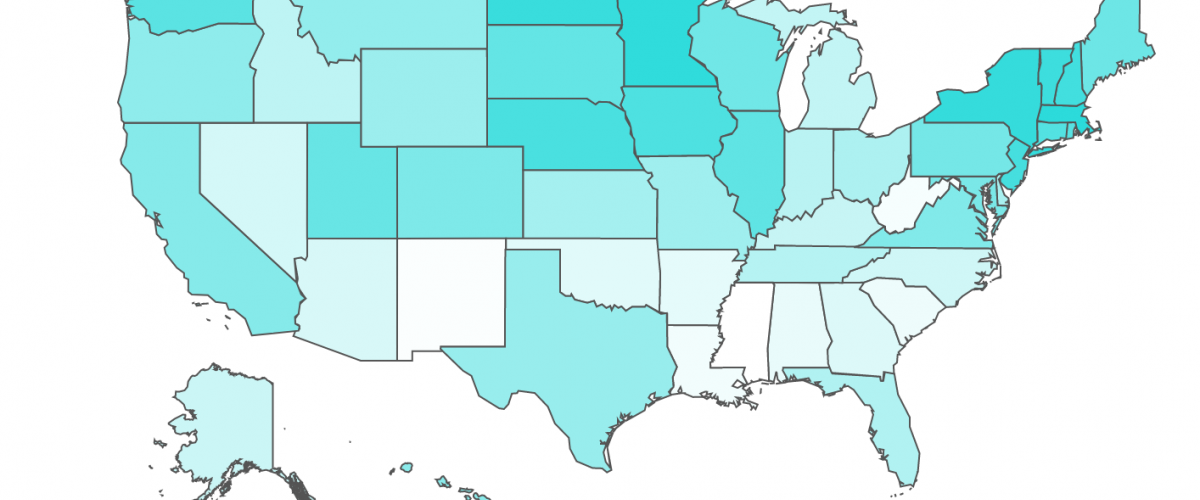By Adam McCann
(Minnesota) — January 9th, 2023 — Raising a healthy, stable family sometimes requires moving to a new state. The reasons people choose to move are often similar: career transitions, better schools, financial challenges or a general desire to change settings. Wants and needs don’t always align in a particular state, though. For instance, a state might offer a low income-tax rate but have a subpar education system. However, families do not necessarily need to make these kinds of tradeoffs. They can avoid such problems by knowing which states offer the best combination of qualities that matter most to parents and their kids. The ideal city is one that’s affordable to live in during this time of high inflation but also offers quality schools, healthcare and entertainment.
To help with the evaluation process, WalletHub compared the 50 states across 51 key indicators of family-friendliness. Our data set ranges from the median annual family income to housing affordability to the unemployment rate.
Best States for Families
| Overall Rank | State | Total Score | Family Fun | Health & Safety | Education & Child Care | Affordability | Socio-economics |
|---|---|---|---|---|---|---|---|
| 1 | Massachusetts | 66.14 | 9 | 5 | 2 | 2 | 22 |
| 2 | Minnesota | 62.07 | 13 | 8 | 12 | 7 | 5 |
| 3 | New York | 61.11 | 2 | 9 | 14 | 6 | 46 |
| 4 | North Dakota | 59.60 | 32 | 16 | 1 | 16 | 1 |
| 5 | Vermont | 59.27 | 46 | 1 | 7 | 26 | 2 |
| 6 | New Hampshire | 58.17 | 36 | 3 | 5 | 22 | 8 |
| 7 | New Jersey | 58.14 | 23 | 13 | 3 | 3 | 25 |
| 8 | Nebraska | 57.95 | 19 | 10 | 6 | 24 | 6 |
| 9 | Iowa | 57.05 | 31 | 14 | 9 | 9 | 10 |
| 10 | Connecticut | 57.03 | 29 | 7 | 8 | 1 | 31 |
| 11 | Rhode Island | 56.95 | 27 | 4 | 19 | 4 | 27 |
| 12 | Washington | 56.30 | 8 | 23 | 31 | 5 | 19 |
| 13 | Illinois | 55.49 | 4 | 29 | 25 | 11 | 45 |
| 14 | South Dakota | 55.45 | 30 | 12 | 11 | 25 | 7 |
| 15 | Utah | 55.25 | 18 | 19 | 15 | 33 | 4 |
| 16 | Maine | 55.01 | 45 | 2 | 4 | 32 | 14 |
| 17 | Wisconsin | 54.86 | 21 | 25 | 13 | 13 | 11 |
| 18 | Pennsylvania | 53.89 | 11 | 21 | 24 | 17 | 20 |
| 19 | Maryland | 53.39 | 25 | 17 | 10 | 8 | 36 |
| 20 | Colorado | 53.34 | 7 | 31 | 32 | 19 | 15 |
| 21 | Virginia | 52.60 | 28 | 15 | 17 | 20 | 17 |
| 22 | California | 52.04 | 1 | 32 | 45 | 21 | 40 |
| 23 | Hawaii | 51.36 | 15 | 6 | 33 | 40 | 23 |
| 24 | Oregon | 50.55 | 10 | 20 | 40 | 14 | 26 |
| 25 | Montana | 50.49 | 34 | 24 | 18 | 46 | 3 |
| 26 | Texas | 49.71 | 3 | 47 | 29 | 35 | 44 |
| 27 | Wyoming | 49.60 | 37 | 11 | 16 | 45 | 12 |
| 28 | Missouri | 49.21 | 22 | 34 | 23 | 27 | 16 |
| 29 | Kansas | 49.21 | 38 | 35 | 22 | 18 | 13 |
| 30 | Delaware | 47.91 | 44 | 22 | 21 | 12 | 38 |
| 31 | Ohio | 47.69 | 16 | 28 | 36 | 15 | 42 |
| 32 | Florida | 47.28 | 6 | 39 | 30 | 50 | 35 |
| 33 | Tennessee | 46.17 | 20 | 40 | 26 | 30 | 24 |
| 34 | Indiana | 45.77 | 33 | 38 | 27 | 23 | 18 |
| 35 | Idaho | 45.74 | 39 | 18 | 43 | 44 | 9 |
| 36 | Michigan | 45.51 | 41 | 26 | 41 | 10 | 28 |
| 37 | Kentucky | 45.40 | 43 | 30 | 20 | 28 | 34 |
| 38 | Alaska | 44.74 | 17 | 27 | 44 | 37 | 21 |
| 39 | North Carolina | 43.11 | 24 | 37 | 37 | 39 | 29 |
| 40 | Nevada | 41.41 | 5 | 42 | 49 | 49 | 48 |
| 41 | Arizona | 40.40 | 12 | 36 | 48 | 48 | 33 |
| 42 | Georgia | 40.24 | 26 | 46 | 35 | 41 | 41 |
| 43 | Oklahoma | 38.48 | 40 | 48 | 39 | 31 | 43 |
| 44 | Arkansas | 38.47 | 48 | 45 | 28 | 34 | 32 |
| 45 | Alabama | 37.38 | 47 | 44 | 38 | 29 | 37 |
| 46 | South Carolina | 37.16 | 42 | 41 | 46 | 38 | 39 |
| 47 | Louisiana | 36.80 | 14 | 49 | 47 | 36 | 49 |
| 48 | West Virginia | 34.86 | 50 | 33 | 42 | 43 | 30 |
| 49 | New Mexico | 30.78 | 35 | 43 | 50 | 47 | 47 |
| 50 | Mississippi | 30.01 | 49 | 50 | 34 | 42 | 50 |
Note: With the exception of “Total Score,” all of the columns in the table above depict the relative rank of that state, where a rank of 1 represents the best conditions for that metric category.
Methodology
In order to determine the best states to raise a family, WalletHub compared the 50 states across five key dimensions: 1) Family Fun, 2) Health & Safety, 3) Education & Child Care, 4) Affordability and 5) Socio-economics.
We evaluated those dimensions using 51 relevant metrics, which are listed below with their corresponding weights. Each metric was graded on a 100-point scale, with a score of 100 representing the most favorable conditions for family life.
Finally, we determined each state’s weighted average across all metrics to calculate its overall score and used the resulting scores to rank-order the states.
Family Fun – Total Points: 20
- Share of Families with Young Children: Full Weight (~3.33 Points)
Note: “Young Children” includes the population aged 0 to 17. - Number of Attractions: Triple Weight (~10.00 Points)
- Fitness & Recreational Sports Centers per Capita: Full Weight (~3.33 Points)
- Share of Children Aged 0 to 17 Who Live in Neighborhoods with a Park or Playground: Full Weight (~3.33 Points)
Health & Safety – Total Points: 20
- Percentage of Residents Aged 12+ Who Are Fully Vaccinated Against COVID-19: Double Weight (~2.42 Points)
- Share of Uninsured Children: Full Weight (~1.21 Points)
Note: “Children” includes the population aged 0 to 18. - Pediatricians per Capita: Full Weight (~1.21 Points)
- Number of Children’s Hospitals per Total Number of Children Aged 0 to 17: Full Weight (~1.21 Points)
- Quality of Public Hospitals: Full Weight (~1.21 Points)
Note: This metric is based on public-hospital ratings from the Centers for Medicare & Medicaid Services. - Infant-Mortality Rate: Full Weight (~1.21 Points)
- Life Expectancy at Birth: Full Weight (~1.21 Points)
- Number of Climate Disasters Causing $1 Billion+ in Damages in Past Decades: Full Weight (~1.21 Points)
- Air Pollution: Full Weight (~1.21 Points)
- Water Quality: Full Weight (~1.21 Points)
- Violent Crimes per Capita: Full Weight (~1.21 Points)
- Property Crimes per Capita: Full Weight (~1.21 Points)
- Share of Children Aged 6 to 17 Who Go to Safe Schools: Full Weight (~1.21 Points)
- Safety Ranking of Roads Around School: Half Weight (~0.61 Points)
Note: School safety scores and rankings are based on unsafe driving events detected by the Zendrive platform within school areas. - Share of Children Aged 0 to 17 Who Live in Supportive Neighborhoods: Full Weight (~1.21 Points)
Note: Supportive neighborhoods are neighborhoods where people help each other out, watch out for each other’s children and know where to go for help in the community. - Share of Children Aged 0 to 17 Living with Parents Who Have Support: Full Weight (~1.21 Points)
Note: This metric refers to children whose parents have someone to turn to for day-to-day emotional support with parenting or raising children.
Education & Child Care – Total Points: 20
- Quality of Public Schools: Double Weight (~4.00 Points)
Note: This metric is based on WalletHub’s “States with the Best & Worst School Systems” ranking. - Public High School Graduation Rate: Full Weight (~2.00 Points)
- Child Day-Care Services per Capita: Full Weight (~2.00 Points)
- Day-Care Quality: Full Weight (~2.00 Points)
- Child-Care Costs: Full Weight (~2.00 Points)
Note: This metric was adjusted for the median family income. - Parental Leave: Full Weight (~2.00 Points)
Note: This metric is based on parental-leave policy scores from the National Partnership for Women & Families. - Number of Childcare Workers per Total Number of Children: Full Weight (~2.00 Points)
- Share of Children Aged 6 to 17 Who Participate in School Extracurricular Activities: Full Weight (~2.00 Points)
- Share of Children Aged 6 to 17 Who Participate in Community Service or Volunteer Work: Full Weight (~2.00 Points)
Affordability – Total Points: 20
- Housing Affordability: Full Weight (~1.82 Points)
Note: This metric was calculated as follows: Housing Costs (accounts for both rental and sale prices) / Median Annual Family Income. - Median Credit Score: Full Weight (~1.82 Points)
- Median Mortgage Debt: Full Weight (~1.82 Points)
Note: This metric measures the median amount of mortgage debt per adult, as share of median earnings. - Median Non-Mortgage Debt: Full Weight (~1.82 Points)
Note: This metric measures the median amount of non-mortgage debt per adult, as share of median earnings. - Share of People Who Save Money for their Children’s College Education: Full Weight (~1.82 Points)
- Share of Children Aged 0 to 17 Whose Family Had Problems Paying Medical Bills: Full Weight (~1.82 Points)
Note: This metric refers to children whose family had problems paying for the children’s medical or health care bills during the past 12 months. - Paid Family Leave: Double Weight (~3.64 Points)
- Retirement Access & Participation: Full Weight (~1.82 Points)
Note: “Retirement” refers to employer-based plans only. - Median Annual Family Income: Full Weight (~1.82 Points)
Note: This metric was adjusted for the cost of living. - Average Annual Family Health Insurance Premium: Full Weight (~1.82 Points)
Socio-economics – Total Points: 20
- Separation & Divorce Rate: Full Weight (~1.67 Points)
- Median Duration of Current Marriage: Full Weight (~1.67 Points)
- Share of Two-Parent Families: Full Weight (~1.67 Points)
- Wealth Gap: Full Weight (~1.67 Points)
- Share of Families Living in Poverty: Full Weight (~1.67 Points)
- Share of Families Receiving Food Stamps: Full Weight (~1.67 Points)
- Unemployment Rate: Full Weight (~1.67 Points)
- Underemployment Rate: Full Weight (~1.67 Points)
- Job Security: Full Weight (~1.67 Points)
Note: This metric was calculated as follows: (Number of Employees in 2022 September – Number of Employees in 2021 September) / Number of Employees in 2021 September. - Job Opportunities: Full Weight (~1.67 Points)
Note: This metric was calculated as follows: Number of Job Openings per Number of Population in Labor Force Minus Unemployed Rate. - Job Satisfaction Score: Full Weight (~1.67 Points)
- Foreclosure Rate: Full Weight (~1.67 Points)
Sources: Data used to create this ranking were collected from the U.S. Census Bureau, Bureau of Labor Statistics, National Center for Education Statistics, Child Care Aware of America, Centers for Medicare & Medicaid Services, Centers for Disease Control and Prevention, Council for Community and Economic Research, Federal Bureau of Investigation, U.S. Department of Housing and Urban Development, National Partnership for Women & Families, TransUnion, The Pew Charitable Trusts, United Health Foundation, Indeed, U.S. News & World Report, Institute for Health Metrics and Evaluation, National Climatic Data Center, FINRA Investor Education Foundation, U.S. Department of Health and Human Services, Kaiser Family Foundation, ATTOM Data Solutions, Brandwatch, Zendrive, TripAdvisor and WalletHub research.






